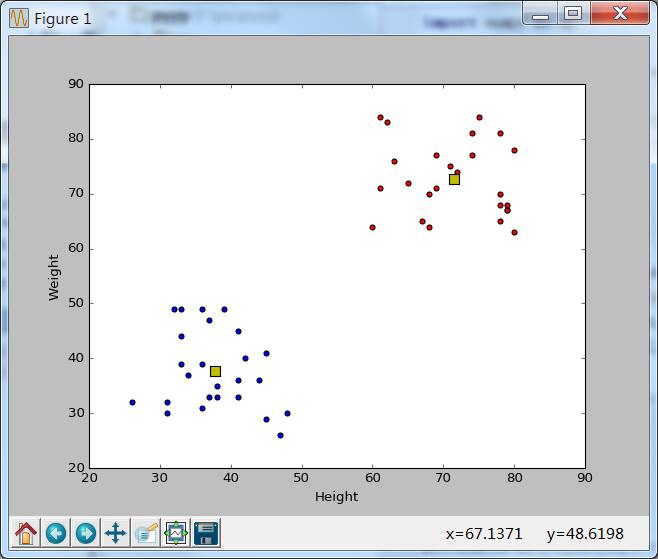机器学习笔记关于python实现Kmean算法
Posted Mnster_Lu
tags:
篇首语:本文由小常识网(cha138.com)小编为大家整理,主要介绍了机器学习笔记关于python实现Kmean算法相关的知识,希望对你有一定的参考价值。
这次是一个关于Kmean的类聚算法,
简单来说就是到中心点的距离的加权和
看起来很厉害
写出来一点不厉害
一、随机取点
import numpy as np import cv2 from matplotlib import pyplot as plt X = np.random.randint(25,50,(25,2)) Y = np.random.randint(60,85,(25,2)) Z = np.vstack((X,Y)) # convert to np.float32 Z = np.float32(Z) plt.hist(Z,100,[0,100]),plt.show()

二、kmean部分
调用cv2库里的kmean
对A、B两类进行标记
# define criteria and apply kmeans() criteria = (cv2.TERM_CRITERIA_EPS + cv2.TERM_CRITERIA_MAX_ITER, 10, 1.0) ret,label,center=cv2.kmeans(Z,2,None,criteria,10,cv2.KMEANS_RANDOM_CENTERS) # Now separate the data, Note the flatten() A = Z[label.ravel()==0] B = Z[label.ravel()==1]
三、类聚结果
画图画图画图
# Plot the data plt.scatter(A[:,0],A[:,1]) plt.scatter(B[:,0],B[:,1],c = \'r\') plt.scatter(center[:,0],center[:,1],s = 80,c = \'y\', marker = \'s\') plt.xlabel(\'Height\'),plt.ylabel(\'Weight\') plt.show()

------------------------------------------------------------------------------------------------------------------------------------------------------
最后
代码汇总
import numpy as np import cv2 from matplotlib import pyplot as plt X = np.random.randint(25,50,(25,2)) Y = np.random.randint(60,85,(25,2)) Z = np.vstack((X,Y)) # convert to np.float32 Z = np.float32(Z) plt.hist(Z,100,[0,100]),plt.show() # define criteria and apply kmeans() criteria = (cv2.TERM_CRITERIA_EPS + cv2.TERM_CRITERIA_MAX_ITER, 10, 1.0) ret,label,center=cv2.kmeans(Z,2,None,criteria,10,cv2.KMEANS_RANDOM_CENTERS) # Now separate the data, Note the flatten() A = Z[label.ravel()==0] B = Z[label.ravel()==1] # Plot the data plt.scatter(A[:,0],A[:,1]) plt.scatter(B[:,0],B[:,1],c = \'r\') plt.scatter(center[:,0],center[:,1],s = 80,c = \'y\', marker = \'s\') plt.xlabel(\'Height\'),plt.ylabel(\'Weight\') plt.show()
以上是关于机器学习笔记关于python实现Kmean算法的主要内容,如果未能解决你的问题,请参考以下文章